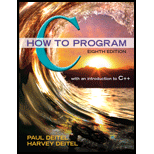
C How to Program (8th Edition)
8th Edition
ISBN: 9780133976892
Author: Paul J. Deitel, Harvey Deitel
Publisher: PEARSON
expand_more
expand_more
format_list_bulleted
Question
Chapter 7, Problem 7.33MD
Program Plan Intro
- Declare prototype for three functions building_CF, car_CF and bicycle_CF.
- Inside main function,
- Declare array of function f to point to three functions building_CF, car_CF and bicycle_CF.
- Declare an integer variable choice to store the user’s choice
- Use while loop to repeatedly take user’s choice and call different function using array of function.
- Define function building_CF. Inside this function ask from user for various parameters that can contribute to CO2 emission. Based on value of these paramters and emission factor calculate the carbon foot print for building.
- Similar as above define function car_CF and bicycle_CF. The CO2 emission of car will be based on type of fuel used in it and for bicyle CO2 emission will depend on the distance travelled.
Summary Introduction: The program uses CO2 emission factors of various fuels used to calculate the carbon footprint for any building, car or bicycle. The program defines three functions for each type of carbon footprint calculation and calls them using array of function.
Program Description:The program prompts the user to enter the type of carbon footprint to calculate and then based on his/her choice uses the array of function to calculate the carbon footprint.
Expert Solution & Answer
Want to see the full answer?
Check out a sample textbook solution
Students have asked these similar questions
1. Transform the E-R diagram into a set of relations.
Country_of
Agent ID
Agent H
Holds
Is_Reponsible_for
Consignment
Number
$ Value
May Contain
Consignment
Transports
Container
Destination
Ф
R
Goes Off
Container
Number
Size
Vessel
Voyage
Registry
Vessel ID
Voyage_ID
Tonnage
I want to solve 13.2 using matlab please help
a) Show a possible trace of the OSPF algorithm for computing the routing table in Router 2 forthis network.b) Show the messages used by RIP to compute routing tables.
Chapter 7 Solutions
C How to Program (8th Edition)
Ch. 7 - Answer each of the following: The _____ operator...Ch. 7 - Prob. 7.10ECh. 7 - Do each of the following: Write the function...Ch. 7 - (Simulation: The Tortoise and the Hare) In this...Ch. 7 - (Card Shuffling and Dealing Modification) Modify...Ch. 7 - What does this program do, assuming that the user...Ch. 7 - What does this program do?Ch. 7 - Find the error in each of the following program...Ch. 7 - (Maze Traversal) The following grid is a...Ch. 7 - Prob. 7.23E
Knowledge Booster
Similar questions
- using r language to answer question 4 Question 4: Obtain a 95% standard normal bootstrap confidence interval, a 95% basic bootstrap confidence interval, and a percentile confidence interval for the ρb12 in Question 3.arrow_forwardusing r language to answer question 4. Question 4: Obtain a 95% standard normal bootstrap confidence interval, a 95% basic bootstrap confidence interval, and a percentile confidence interval for the ρb12 in Question 3.arrow_forwardusing r languagearrow_forward
- using r languagearrow_forwardusing r language Obtain a bootstrap t confidence interval estimate for the correlation statistic in Example 8.2 (law data in bootstrap).arrow_forwardusing r language Compute a jackknife estimate of the bias and the standard error of the correlation statistic in Example 8.2.arrow_forward
- using r languagearrow_forwardusing r languagearrow_forwardThe assignment here is to write an app using a database named CIT321 with a collection named students; we will provide a CSV file of the data. You need to use Vue.js to display 2 pages. You should know that this assignment is similar, all too similar in fact, to the cars4sale2 example in the lecture notes for Vue.js 2. You should study that program first. If you figure out cars4sale2, then program 6 will be extremely straightforward. It is not my intent do drop a ton of new material here in the last few days of class. The database contains 51 documents. The first rows of the CSV file look like this: sid last_name 1 Astaire first_name Humphrey CIT major hrs_attempted gpa_points 10 34 2 Bacall Katharine EET 40 128 3 Bergman Bette EET 42 97 4 Bogart Cary CIT 11 33 5 Brando James WEB 59 183 6 Cagney Marlon CIT 13 40 GPA is calculated as gpa_points divided by hrs_attempted. GPA points would have been arrived at by adding 4 points for each credit hour of A, 3 points for each credit hour of…arrow_forward
arrow_back_ios
SEE MORE QUESTIONS
arrow_forward_ios
Recommended textbooks for you
 C++ Programming: From Problem Analysis to Program...Computer ScienceISBN:9781337102087Author:D. S. MalikPublisher:Cengage Learning
C++ Programming: From Problem Analysis to Program...Computer ScienceISBN:9781337102087Author:D. S. MalikPublisher:Cengage Learning C++ for Engineers and ScientistsComputer ScienceISBN:9781133187844Author:Bronson, Gary J.Publisher:Course Technology Ptr
C++ for Engineers and ScientistsComputer ScienceISBN:9781133187844Author:Bronson, Gary J.Publisher:Course Technology Ptr Microsoft Visual C#Computer ScienceISBN:9781337102100Author:Joyce, Farrell.Publisher:Cengage Learning,
Microsoft Visual C#Computer ScienceISBN:9781337102100Author:Joyce, Farrell.Publisher:Cengage Learning,

C++ Programming: From Problem Analysis to Program...
Computer Science
ISBN:9781337102087
Author:D. S. Malik
Publisher:Cengage Learning

C++ for Engineers and Scientists
Computer Science
ISBN:9781133187844
Author:Bronson, Gary J.
Publisher:Course Technology Ptr

Microsoft Visual C#
Computer Science
ISBN:9781337102100
Author:Joyce, Farrell.
Publisher:Cengage Learning,